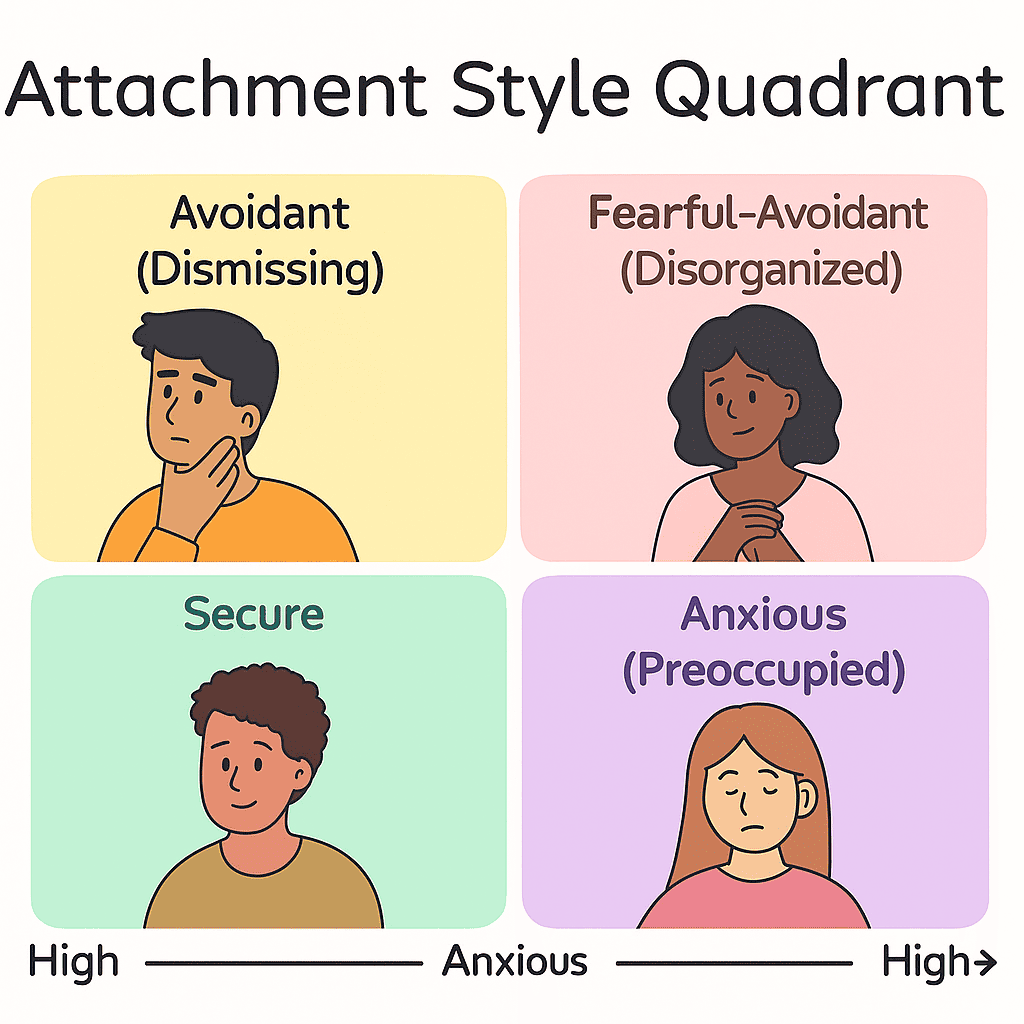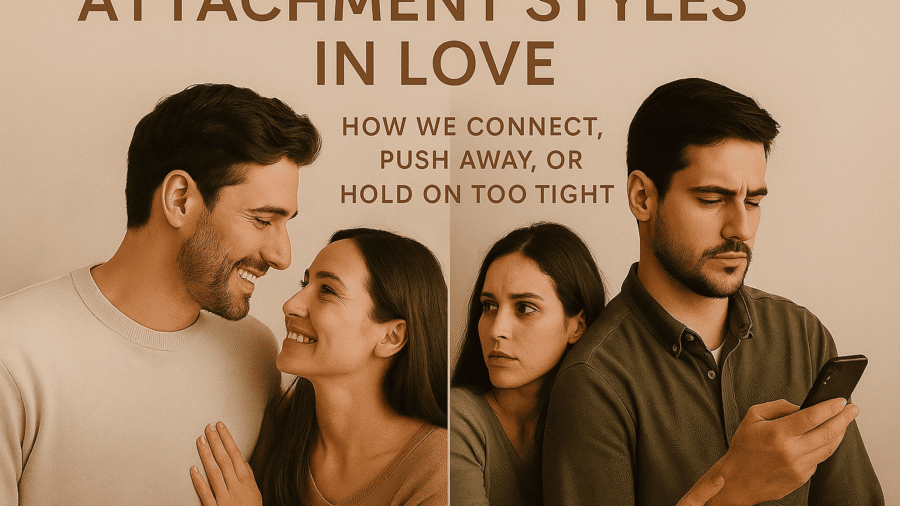Every romantic relationship tells a story. Sometimes, it is not a new story we are writing but we are rather reliving one we have lived before, long ago, even without realising it. These stories reflect the love we deserve. Other times, it reflects wounds we never healed from.
And it brings out its ugly head when we feel abandoned when someone pulls away or suffocated when someone comes too close.
These reactions often stem from something deeper than the moment. They come from our attachment styles. An emotional imprint from your earliest relationships that still whispers what to expect from love, even as an adult. Being aware of your attachment style is not just a matter of self-awareness, it is one of emotional survival. It explains why you may feel overwhelmed by closeness or terrified of abandonment, even in a good relationship.
This post explores how attachment styles in romantic relationships influence the way we connect and how you can heal, grow, and shift your story toward something more secure, nurturing, and deeply fulfilling.
What Are Attachment Styles?
Attachment styles are behavouirs we unconsciously acquire at a young age, normally from how we were cared for as children. These patterns influence how we connect with others, especially in our romantic relationships. They affect how close we feel, how we handle conflict, and how safe we feel with someone we love.
There are four major types:
- Secure Attachment: You feel safe with others. You enjoy closeness but are also comfortable on your own.
- Anxious/Preoccupied Attachment: You deeply want closeness but often fear that people will leave or stop loving you (fears abandonment).
- Avoidant/Dismissive Attachment: You like to stay independent. Too much closeness can feel overwhelming, so you keep some distance and often hide emotional needs.
- Fearful-Avoidant (Disorganised): You want love but are also afraid of it. You may attract people, then push them away time and time again without even knowing it.
These styles are not labels. They are coping patterns. And they can evolve with awareness, support, and safe relationships.

How Secure Attachment Builds Healthy Love
According to a recent study that was published in PubMed Central, individuals with secure attachment styles experience higher levels of relationship satisfaction, trust, and emotional regulation. They are more likely to:
- Be open in expressing needs
- Support their partners’ growth
- Be good at Conflict Resolution
- Be emotionally available
These behaviours foster emotional safety, a key ingredient in long-lasting romantic connection.
The Anxious Attachment Style: Craving Closeness, Fearing Loss
People with anxious attachment often feel unworthy of love unless they are reassured. Their minds are like radios stuck on the “threat” station always fearing rejection or abandonment.
PubMed Central studies confirms that these individuals tend to ruminate more during conflicts, express greater relationship insecurity, and may feel more distressed when their needs are not met.
Some signs may include:
- Texting repeatedly when a partner is distant
- Seeking constant affirmation
- Feeling jealous or suspicious
- Overanalysing every interaction
But this is not “neediness.” It is the echo of unmet needs from early caregiving. Healing begins by naming the fear and learning to soothe it without demanding others fix it.
If you want to understand how these patterns play out in daily life, the article How to Handle Relationship Anxiety offers strategies for recognising anxious patterns and responding with secure behaviors.

The Avoidant Style: Intimacy Feels Unsafe
When secure attachment says, “I can count on you,” avoidant attachment says, “Depending on you is dangerous.” These individuals often grew up in environments where vulnerability was discouraged or punished.
They may act independent or even aloof in relationships but underneath lies a fear of engulfment or being judged for emotional needs.
According to PubMed Central studies, avoidantly attached individuals often suppress distress, pull away from conflict, and cherish autonomy over intimacy.
Behaviours may include:
- Shutting down during conflict
- Keeping emotional distance
- Avoiding labels or making future plans
- Focusing on flaws in a partner to justify detachment
Fearful-Avoidant: Love and Fear in the Same Breath
The fearful-avoidant style combines traits from both anxious and avoidant patterns. It is usually caused by trauma, loss, or neglect, where the caregiver was both a source of comfort and harm.
This creates a painful conflict: craving intimacy yet fearing it. These individuals may start relationships with intensity, then pull away the moment vulnerability surfaces.
Signs may include:
- Hot-and-cold behaviour
- Fear of rejection and intimacy
- Self-sabotaging relationships
- Fluctuating between clinginess and withdrawal
This style deserves compassion and often benefits from trauma-informed therapy and safe relational experiences to unlearn chaotic bonds.
How to Change Your Attachment Style
Attachment styles are not life sentences. They are learned, so they can be unlearned or reshaped.
Steps toward secure attachment include:
- Self-awareness – Naming your pattern with honesty and without shame.
- Emotion regulation – Learning to soothe your nervous system before reacting.
- Therapy – Especially Emotionally Focused Therapy or Internal Family Systems, which target core relational wounds.
- Communicating needs – Practicing direct and vulnerable expressions of what you want.
- Choosing safe partners – People who respect your boundaries, stay consistent, and meet conflict with care.
You can also begin this process by understanding the roots of security in childhood. The post Secure Attachment: What Every Parent Should Know offers timeless insights that apply in both parenting and adult relationships.

Where do you Stand? Your Story Can Change
Love is not just found. It is created, again and again, in small moments of safety, honesty, and presence. Whether you lean anxious, avoidant, or fearful, the story of how you relate to others can be rewritten.
Your attachment style is a survival map drawn in your earliest years. But you are no longer that child. You are the author now and you have the power to turn your relationships into places of healing, not repetition.



[…] our “Attachment Styles“. These are invisible blueprint of how we expect others to treat us. For example, a child who […]